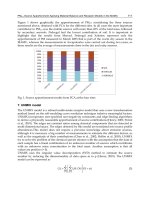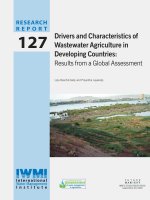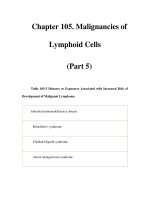Chapter 127. Treatment and Prophylaxis of Bacterial Infections (Part 5) pdf
Bạn đang xem bản rút gọn của tài liệu. Xem và tải ngay bản đầy đủ của tài liệu tại đây (14.52 KB, 5 trang )
Chapter 127. Treatment and Prophylaxis
of Bacterial Infections
(Part 5)
Vancomycin
Clinically important resistance to vancomycin was first described among
enterococci in France in 1988. Vancomycin-resistant enterococci (VRE) have
subsequently become disseminated worldwide. The genes encoding resistance are
carried on plasmids that can transfer themselves from cell to cell and on
transposons that can jump from plasmids to chromosomes. Resistance is mediated
by enzymes that substitute D-lactate for D-alanine on the peptidoglycan stem
peptide so that there is no longer an appropriate target for vancomycin binding.
This alteration does not appear to affect cell-wall integrity, however. This type of
acquired vancomycin resistance was confined for 14 years to enterococci—more
specifically, to Enterococcus faecium rather than the more common pathogen E.
faecalis. However, since 2002, S. aureus isolates that are highly resistant to
vancomycin have been recovered from four patients in the United States. All of
the isolates contain vanA, the gene that mediates vancomycin resistance in
enterococci. In addition, since 1996, a few isolates of both S. aureus and
Staphylococcus epidermidis that display a four- to eightfold reduction in
susceptibility to vancomycin have been found worldwide, and many more isolates
may contain subpopulations with reduced vancomycin susceptibility. These
isolates have not acquired the genes that mediate vancomycin resistance in
enterococci but are mutant bacteria with markedly thickened cell walls. These
mutants were apparently selected in patients who were undergoing prolonged
vancomycin therapy. The failure of vancomycin therapy in some patients infected
with S. aureus or S. epidermidis strains exhibiting only intermediate susceptibility
to this drug is thought to have resulted from this resistance.
Aminoglycosides
The most common aminoglycoside resistance mechanism is inactivation of
the antibiotic. Aminoglycoside-modifying enzymes, usually encoded on plasmids,
transfer phosphate, adenyl, or acetyl residues from intracellular molecules to
hydroxyl or amino side groups on the antibiotic. The modified antibiotic is less
active because of diminished binding to its ribosomal target. Modifying enzymes
that can inactivate any of the available aminoglycosides have been found in both
gram-positive and gram-negative bacteria. A second aminoglycoside resistance
mechanism, which has been identified predominantly in clinical isolates of
Pseudomonas aeruginosa, is decreased antibiotic uptake, presumably due to
alterations in the bacterial outer membrane.
Macrolides, Ketolides, Lincosamides, and Streptogramins
Resistance in gram-positive bacteria, which are the usual target organisms
for macrolides, ketolides, lincosamides, and streptogramins, can be due to the
production of an enzyme—most commonly plasmid-encoded—that methylates
ribosomal RNA, interfering with binding of the antibiotics to their target.
Methylation mediates resistance to erythromycin, clarithromycin, azithromycin,
clindamycin, and streptogramin B. Resistance to streptogramin B converts
quinupristin/dalfopristin from a bactericidal to a bacteriostatic antibiotic.
Streptococci can also actively cause the efflux of macrolides, and staphylococci
can cause the efflux of macrolides, clindamycin, and streptogramin A. Ketolides
such as telithromycin retain activity against most isolates of Streptococcus
pneumoniae that are resistant to macrolides. In addition, staphylococci can
inactivate streptogramin A by acetylation and streptogramin B by either
acetylation or hydrolysis. Finally, mutations in 23S ribosomal RNA that alter the
binding of macrolides to their targets have been found in both staphylococci and
streptococci.
Chloramphenicol
Most bacteria resistant to chloramphenicol produce a plasmid-encoded
enzyme, chloramphenicol acetyltransferase, that inactivates the compound by
acetylation.
Tetracyclines and Tigecycline
The most common mechanism of tetracycline resistance in gram-negative
bacteria is a plasmid-encoded active-efflux pump that is inserted into the
cytoplasmic membrane and extrudes antibiotic from the cell. Resistance in gram-
positive bacteria is due either to active efflux or to ribosomal alterations that
diminish binding of the antibiotic to its target. Genes involved in ribosomal
protection are found on mobile genetic elements. A new parenteral tetracycline
derivative (a glycylcycline), tigecycline, is active against tetracycline-resistant
bacteria because it is not removed by efflux and can bind to altered ribosomes.
Mupirocin
Although the topical compound mupirocin was introduced into clinical use
relatively recently, resistance is already becoming widespread in some areas. The
mechanism appears to be either mutation of the target isoleucine tRNA synthetase
so that it is no longer inhibited by the antibiotic or plasmid-encoded production of
a form of the target enzyme that binds mupirocin poorly.
Trimethoprim and Sulfonamides
The most prevalent mechanism of resistance to trimethoprim and the
sulfonamides in both gram-positive and gram-negative bacteria is the acquisition
of plasmid-encoded genes that produce a new, drug-insensitive target—
specifically, an insensitive dihydrofolate reductase for trimethoprim and an altered
dihydropteroate synthetase for sulfonamides.
Quinolones
The most common mechanism of resistance to quinolones is the
development of one or more mutations in target DNA gyrases and topoisomerase
IV that prevent the antibacterial agent from interfering with the enzymes' activity.
Some gram-negative bacteria develop mutations that both decrease outer-
membrane porin permeability and cause active drug efflux from the cytoplasm.
Mutations that result in active quinolone efflux are also found in gram-positive
bacteria.









